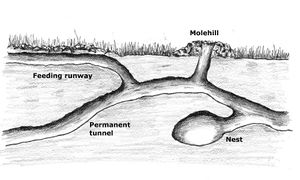Difference between revisions of "Moles"
| Line 1: | Line 1: | ||
[[File:Mole Picture.jpg|thumb|This is an Eastern Mole, a member of the Talpidae family, of which it and other moles belong to. (This image is in the public domain.)]] | [[File:Mole Picture.jpg|thumb|This is an Eastern Mole, a member of the Talpidae family, of which it and other moles belong to. (This image is in the public domain.)]] | ||
| − | Moles are subterranean macro-fauna that belong to the family Talpidae. They are often considered pests due to their burrowing habits, which can disturb soil and (indirectly) damage plants, but this can be beneficial as well. Due to these habits, moles can be considered ecosystem engineers. There are seven identified species of mole in North America: the Eastern Mole (Scalopus aquaticus), the Hairy-Tailed Mole (Parascalops breweri), the Star-Nosed Mole (Condylura cristata), the Broad-Footed Mole (Scapanus latimanus), Townsend’s Mole (Scapanus townsendii), the Coast Mole (Scapanus orarius) and the Shrew Mole (Neurotrichus gibbsii). [1] | + | Moles are subterranean macro-fauna that belong to the family Talpidae. They are often considered pests due to their burrowing habits, which can disturb soil and (indirectly) damage plants, but this can be beneficial as well. Due to these habits, moles can be considered ecosystem engineers. There are seven identified species of mole in North America: the Eastern Mole (''Scalopus aquaticus''), the Hairy-Tailed Mole (''Parascalops breweri''), the Star-Nosed Mole (''Condylura cristata''), the Broad-Footed Mole (''Scapanus latimanus''), Townsend’s Mole (''Scapanus townsendii''), the Coast Mole (''Scapanus orarius'') and the Shrew Mole (''Neurotrichus gibbsii''). [1] |
== Taxonomy == | == Taxonomy == | ||
Revision as of 15:08, 27 April 2018
Moles are subterranean macro-fauna that belong to the family Talpidae. They are often considered pests due to their burrowing habits, which can disturb soil and (indirectly) damage plants, but this can be beneficial as well. Due to these habits, moles can be considered ecosystem engineers. There are seven identified species of mole in North America: the Eastern Mole (Scalopus aquaticus), the Hairy-Tailed Mole (Parascalops breweri), the Star-Nosed Mole (Condylura cristata), the Broad-Footed Mole (Scapanus latimanus), Townsend’s Mole (Scapanus townsendii), the Coast Mole (Scapanus orarius) and the Shrew Mole (Neurotrichus gibbsii). [1]
Taxonomy
Domain: Eukaryota
Kingdom: Animalia
Phylum: Chordata
Class: Mammalia
Order: Insectivora
Family: Talpidae
This simplified list omits sub-categories. Moles may be confused as rodents (Order Rodentia) but this is incorrect.
Description
Moles are typically 17.6 cm in length and 115 g in mass for males and 16.8 cm and 85 g for females. Other than these measurement differences, sexual dimorphism is minimal. [1] Males are called "boars" and females are called "sows", similar to bovines. [2] They are well-suited to subterranean lifestyles, often having long but narrow snouts of approximately 1.3 cm for hunting in their tunnels and large forelimbs to carve their ways through the earth. On their noses are Eimer's organs, which are sensory in nature and used to detect prey below the surface. [3] They prefer loose, moist, earthworm-abundant soils, typically in forested areas. [1] However, they are also often found in grasslands, meadows, and lawns. [4] Their eyes and ears are small and covered completely by fur, with no external flaps for the latter. They have forefeet that are broader than they are long, with webbed toes. Their hind feet are smaller, narrow, and clawed. [1] They are found throughout North America and Eurasia, [4]
Lifestyle
Moles are generally solitary, with the exception of the star-nosed mole, which lives in colonies. They live in dens, but construct networks of tunnels through their hunting grounds. [1] Reproduction occurs in late winter, with gestation taking 42 days. [2] Moles are able to breathe in their cramped tunnels with blood adapted to have greater carbon dioxide capacities, allowing the mole to utilize and process air it has already used. [5] This remarkable adaptation allows moles to remain underground without suffocating.
Diet
Moles are insectivores that hunt below the surface. Generally, moles feast upon insects, slugs, grubs, and earthworms. [2] The consumption of grubs is an often-overlooked benefit of moles, but their consumption of earthworms is detrimental due to the plethora of benefits earthworms provide for soils. For consuming earthworms, moles can poison them with their saliva, which paralyzes them, and then store them for later feasting. Moles have also been known to eat small mice. [4] Contrary to popular belief, moles do not feed on plant roots. This is done by rodents, for which moles are often mistaken.
Relationship with Humans
Moles are traditionally considered pests, causing destruction to lawns, gardens, and farms, but moles can be beneficial for an area's soil. They can aerate it and prey on grubs, which often damage plant roots. [6] Nevertheless, moles are still usually considered undesirable due to their mole hills and mole runs, which are often considered undesirable in one's lawn. [2] These are both composed of disturbed dirt caused by burrowing. Due to their generally unwanted status, humans have developed a variety of ways to discourage, trap, or kill moles, with some methods being more effective than others. [5]
References
[1] F. Robert Henderson. "Moles". Internet Center for Wildlife Damage Management. 2005. Retrieved 2018-04-16. http://icwdm.org/handbook/mammals/Moles.asp
[2] "Facts About Moles". Havahart. http://www.havahart.com/mole-facts
[3] "Moles, Shrew Moles, And Desmans (Talpidae)". Grzimek's Animal Life Encyclopedia. Encyclopedia.com. Retrieved 2018-04-19. https://www.encyclopedia.com/environment/encyclopedias-almanacs-transcripts-and-maps/moles-shrew-moles-and-desmans-talpidae
[4] "How to get rid of moles". Exterminate.com. Retrieved 2018-04-19. http://www.extermine.com/moles.html
[5] "Secret of how moles breathe underground revealed". Telegraph.co.uk. Retrieved 2018-04-19. https://web.archive.org/web/20100723133025/http://www.telegraph.co.uk/science/science-news/7899216/Secret-of-how-moles-breathe-underground-revealed.html
[6] "Moles 'Can Benefit Gardeners'. Hartley Botanic. July 17, 2012. Retrieved 2018-04-16. https://hartley-botanic.com/magazine/801409421-moles-can-benefit-gardeners/

